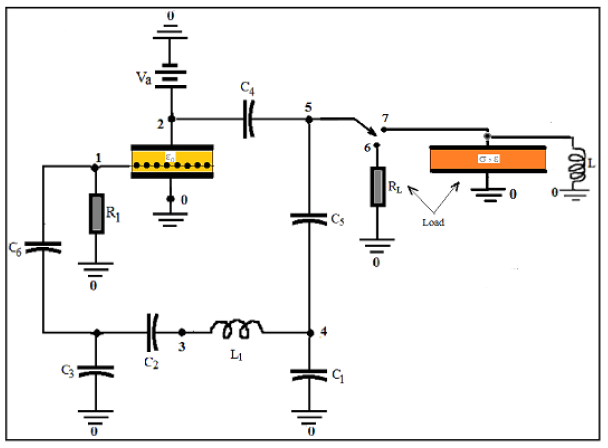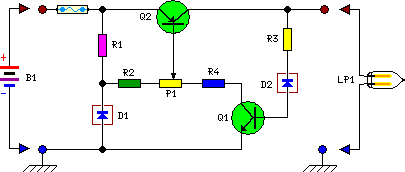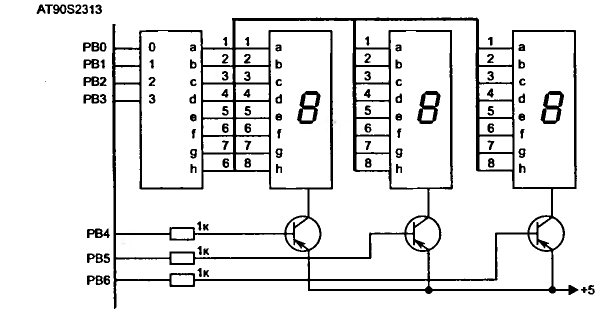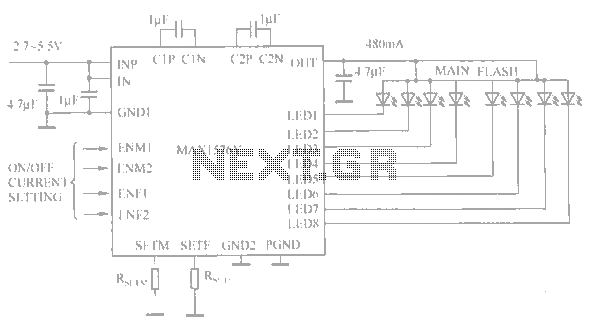
PWM Controller Simplifies High Power LED Designs
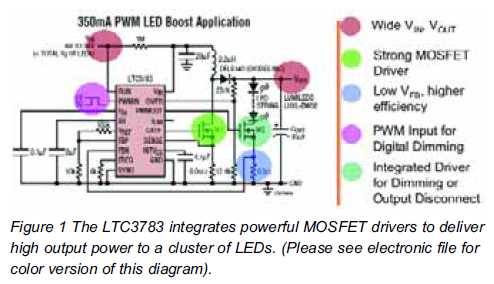
High brightness (HB) and super HB LEDs are utilized in LCD TFT backlighting for high-end televisions, industrial lighting, and projectors. A notable application is in instrument panel backlighting, interior lighting, and brake lights of various vehicles. Luxury automobile manufacturers are increasingly adopting the latest solid-state LED technologies to enhance the aesthetics of their 2007-2008 model vehicles, utilizing these lighter, smaller, and more durable devices for both interior and exterior illumination. LEDs offer lower long-term costs and longer lifespans compared to incandescent bulbs for interior lighting, as well as HID (high-intensity discharge) and halogen lamps for headlights. Operating LEDs at high currents necessitates the use of a DC/DC converter to regulate the current accurately, ensuring uniform light intensity and color fidelity while protecting the LEDs. Additionally, a significant challenge is powering one or multiple strings of LEDs from a battery voltage that may be lower, equal to, or higher than the load voltage. Efficient dimming of the LEDs across a wide range of brightness levels while maintaining their chromatic characteristics is another concern. Furthermore, efficient operation of the DC/DC driver is critical, especially for high-brightness LEDs, as any power not converted into light is dissipated as heat. The LTC3783 from Linear Technology is a current-mode multitopology converter designed for driving high-power LED strings and clusters, featuring constant-current PWM dimming. Proprietary techniques enable rapid, true PWM load switching without transient undervoltage or overvoltage issues, achieving dimming ratios of 3000:1 (at 100Hz) through True Color PWM, which guarantees the color integrity of white and RGB LEDs. The LTC3783 also allows for an additional 100:1 dimming ratio using analog control. This capability is significant since the human eye is highly sensitive to slight changes in ambient light. This versatile controller can be configured as a boost, buck, buck-boost, SEPIC, or flyback converter, and functions as a constant-current/constant-voltage regulator. The device operates without an RSENSE, utilizing a MOSFET's on-resistance to eliminate the need for a current-sense resistor, thereby enhancing efficiency. Applications for the LTC3783 span high-voltage LED arrays, LED backlighting, and voltage regulation in telecommunications, automotive, and industrial control systems. A typical LTC3783 circuit schematic in a boost configuration for driving high-power LED strings is detailed in Figure 1. Its key performance features include:
1. High Voltage: The LTC3783 operates with an input voltage range of 3V to 36V, with an output voltage that can be adjusted based on external power component selections, making it capable of driving LED strings (series) or clusters (series + parallel).
2. Protection: The integrated circuit includes precise current and output voltage regulation to safeguard HB LEDs, along with overvoltage, overcurrent, and soft-start protections.
3. Dimming: The True Color PWM digital dimming achieves a 3000:1 ratio, preserving constant color across a broad dimming range. Additionally, the LTC3783 supports an analog 100:1 dimming ratio. Dimming serves multiple purposes in HB LED applications, including adjusting LED brightness, protecting LEDs from overheating by reducing brightness, and creating various colors by separately dimming red, green, and blue LEDs.
4. Multi-Topology: The LTC3783 can be configured for various LED arrangements, including buck, boost, buck-boost, or flyback configurations. This flexibility allows a single IC to meet diverse system requirements irrespective of the input-output voltage ratio.
To effectively drive a string or cluster of high brightness or super high brightness LEDs, the driver controller must provide accurate current and voltage regulation, protection circuitry, and dimming capabilities. These LEDs are commonly found in large LCD TFT backlighting applications.High brightness (HB) and super HB LEDs are found in LCD TFT backlighting in highend TVs, industrial lighting, and projectors. One popular area is for instrument panel backlighting, interior lighting, and the brake lights of many cars and trucks.
Luxury automobile manufacturers are increasingly taking advantage of the latest technologies in solid-s tate LED lighting to enhance the aesthetics of their 2007-2008 model vehicles by relying on these lighter, smaller, and more durable devices for interior and exterior illumination. LEDs promise lower long-term cost and longer life which are among many advantages over incandescent light bulbs for interior lighting, for example, and HID (high-intensity discharge) and halogen lamps for headlights.
Driving LEDs at high current requires a DC/DC converter to accurately regulate the current to ensure uniform light intensity and color integrity as well as to protect the LEDs. Furthermore, a significant challenge is to power one or several strings of LEDs from a battery voltage that can be less than, equal to, or higher than its load voltage.
Yet another concern is to efficiently dim the LEDs over a large dimming ratio while preserving their chromatic characteristics at both low and high brightness levels. Furthermore, efficient operation of the DC/DC driver is a crucial requirement, especially in driving HB (high brightness) LEDs, since all the power not emitted as light is dissipated as heat.
The new LTC3783 from Linear Technology is a current-mode multitopology converter with constant-current PWM dimming for driving high-power LED strings and clusters. Proprietary techniques provide extremely fast, true PWM load switching with no transient undervoltage or overvoltage issues: dimming ratios of 3000:1 (at 100Hz) can be achieved digitally as True Color PWM dimming guarantees color integrity of white and RGB LEDs.
The LTC3783 allows an additional 100:1 dimming ratio using analog control. This is an important criterion since the human eye is extremely sensitive to minor changes in ambient light. This versatile controller can be used as a boost, buck, buck-boost, SEPIC, or flyback converter, and as a constantcurrent/ constant-voltage regulator.
No RSENSE operation uses a MOSFET`s on-resistance to eliminate the current-sense resistor and increase efficiency. Applications for the LTC3783 include high-voltage LED arrays and LED backlighting, as well as voltage regulators in telecom, automotive and industrial control systems.
Figure 1 details a typical LTC3783 circuit schematic in a boost configuration to drive a string of high power LEDs. Its key performance features are defined in areas one through five. High Voltage: The LTC3783`s 3V to 36V input operation and an output voltage that is scalable depending on the choices of the external power components, easily drives strings (series) or clusters (series + parallel) of LEDs.
Protection: The IC incorporates accurate current and output voltage regulation necessary to protect HB LEDs. Additional protections include overvoltage, overcurrent, and soft start. Dimming: With True ColorG¤ PWM 3000:1 digital dimming the LED`s constant color is preserved over a wide dimming ratio.
Also, the LTC3783 is capable of additional analog 100:1 dimming. Dimming has three uses in HB LED applications: Adjust brightness of LED; Protect the LED by dimming it when LED becomes too hot; create multiple colors by separately dimming red, green, and blue LEDs. Multi-Topology: The LTC3783 can be specified for many LED arrangements as buck, boost, buck-boost, or flyback.
One IC can be qualified for a variety of system requirements independent of input-output voltage ratio. To reliably drive a string or cluster of high brightness or super high brightness LEDs the driver controller must have accurate current and voltage regulation, protection circuitry and dimming capability.
These LEDs are found in large LCD TFT backli 🔗 External reference
1. High Voltage: The LTC3783 operates with an input voltage range of 3V to 36V, with an output voltage that can be adjusted based on external power component selections, making it capable of driving LED strings (series) or clusters (series + parallel).
2. Protection: The integrated circuit includes precise current and output voltage regulation to safeguard HB LEDs, along with overvoltage, overcurrent, and soft-start protections.
3. Dimming: The True Color PWM digital dimming achieves a 3000:1 ratio, preserving constant color across a broad dimming range. Additionally, the LTC3783 supports an analog 100:1 dimming ratio. Dimming serves multiple purposes in HB LED applications, including adjusting LED brightness, protecting LEDs from overheating by reducing brightness, and creating various colors by separately dimming red, green, and blue LEDs.
4. Multi-Topology: The LTC3783 can be configured for various LED arrangements, including buck, boost, buck-boost, or flyback configurations. This flexibility allows a single IC to meet diverse system requirements irrespective of the input-output voltage ratio.
To effectively drive a string or cluster of high brightness or super high brightness LEDs, the driver controller must provide accurate current and voltage regulation, protection circuitry, and dimming capabilities. These LEDs are commonly found in large LCD TFT backlighting applications.High brightness (HB) and super HB LEDs are found in LCD TFT backlighting in highend TVs, industrial lighting, and projectors. One popular area is for instrument panel backlighting, interior lighting, and the brake lights of many cars and trucks.
Luxury automobile manufacturers are increasingly taking advantage of the latest technologies in solid-s tate LED lighting to enhance the aesthetics of their 2007-2008 model vehicles by relying on these lighter, smaller, and more durable devices for interior and exterior illumination. LEDs promise lower long-term cost and longer life which are among many advantages over incandescent light bulbs for interior lighting, for example, and HID (high-intensity discharge) and halogen lamps for headlights.
Driving LEDs at high current requires a DC/DC converter to accurately regulate the current to ensure uniform light intensity and color integrity as well as to protect the LEDs. Furthermore, a significant challenge is to power one or several strings of LEDs from a battery voltage that can be less than, equal to, or higher than its load voltage.
Yet another concern is to efficiently dim the LEDs over a large dimming ratio while preserving their chromatic characteristics at both low and high brightness levels. Furthermore, efficient operation of the DC/DC driver is a crucial requirement, especially in driving HB (high brightness) LEDs, since all the power not emitted as light is dissipated as heat.
The new LTC3783 from Linear Technology is a current-mode multitopology converter with constant-current PWM dimming for driving high-power LED strings and clusters. Proprietary techniques provide extremely fast, true PWM load switching with no transient undervoltage or overvoltage issues: dimming ratios of 3000:1 (at 100Hz) can be achieved digitally as True Color PWM dimming guarantees color integrity of white and RGB LEDs.
The LTC3783 allows an additional 100:1 dimming ratio using analog control. This is an important criterion since the human eye is extremely sensitive to minor changes in ambient light. This versatile controller can be used as a boost, buck, buck-boost, SEPIC, or flyback converter, and as a constantcurrent/ constant-voltage regulator.
No RSENSE operation uses a MOSFET`s on-resistance to eliminate the current-sense resistor and increase efficiency. Applications for the LTC3783 include high-voltage LED arrays and LED backlighting, as well as voltage regulators in telecom, automotive and industrial control systems.
Figure 1 details a typical LTC3783 circuit schematic in a boost configuration to drive a string of high power LEDs. Its key performance features are defined in areas one through five. High Voltage: The LTC3783`s 3V to 36V input operation and an output voltage that is scalable depending on the choices of the external power components, easily drives strings (series) or clusters (series + parallel) of LEDs.
Protection: The IC incorporates accurate current and output voltage regulation necessary to protect HB LEDs. Additional protections include overvoltage, overcurrent, and soft start. Dimming: With True ColorG¤ PWM 3000:1 digital dimming the LED`s constant color is preserved over a wide dimming ratio.
Also, the LTC3783 is capable of additional analog 100:1 dimming. Dimming has three uses in HB LED applications: Adjust brightness of LED; Protect the LED by dimming it when LED becomes too hot; create multiple colors by separately dimming red, green, and blue LEDs. Multi-Topology: The LTC3783 can be specified for many LED arrangements as buck, boost, buck-boost, or flyback.
One IC can be qualified for a variety of system requirements independent of input-output voltage ratio. To reliably drive a string or cluster of high brightness or super high brightness LEDs the driver controller must have accurate current and voltage regulation, protection circuitry and dimming capability.
These LEDs are found in large LCD TFT backli 🔗 External reference
